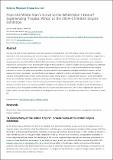Files in this item
From the white man’s grave to the white man’s home? : Experiencing “tropical Africa” at the 1924-1925 British Empire Exhibition
Item metadata
| dc.contributor.author | Skotnes-Brown, Jules | |
| dc.date.accessioned | 2020-07-27T15:30:24Z | |
| dc.date.available | 2020-07-27T15:30:24Z | |
| dc.date.issued | 2019-03-20 | |
| dc.identifier | 269235393 | |
| dc.identifier | b89430ad-012b-4e64-8729-9c6baa84008b | |
| dc.identifier.citation | Skotnes-Brown , J 2019 , ' From the white man’s grave to the white man’s home? Experiencing “tropical Africa” at the 1924-1925 British Empire Exhibition ' , Science Museum Group Journal , vol. Spring 2019 , no. 11 . https://doi.org/10.15180/191101 | en |
| dc.identifier.issn | 2054-5770 | |
| dc.identifier.other | ORCID: /0000-0003-4072-0785/work/77893915 | |
| dc.identifier.uri | https://hdl.handle.net/10023/20342 | |
| dc.description | This article was funded by the Standard Bank Derek Cooper Africa Scholarship. | en |
| dc.description.abstract | The 1924–25 British Empire Exhibition was the largest colonial exposition in British history. Twenty-seven million people explored its 238-acre grounds, gazed at its displays, and marvelled at its architectural wonders. While exhibits ranged from a series of so-called ‘native villages’, to a spectacle of tropical medicine, the official intent was consistent – to promote the development of a more self-sufficient Empire. The exploitation of ‘underdeveloped’ African Crown Colonies was considered important in securing this vision. Eschewing the image of ‘Diseased Africa’, curators sought to encourage temporary settlement and investment by suggesting that medicine had transformed tropical Africa into a land of infinite wealth for the intrepid capitalist. In contrast to many analyses of World’s Fairs, which have focused on catalogues and official materials at the expense of visitor’s narratives, I uncover the tensions between curatorial intention and visitors’ experiences. Through an analysis of divergent responses from science communicators and lay-publics, I argue that the curators’ vision of ‘Brightest Africa’ was sometimes received, sometimes contested, misinterpreted, or lost in translation. This was because the fair was more than a series of exhibits: it was a miniature city, populated by living displayed peoples, which prompted concerns about disease, sanitation, and racial comingling. While catalogues and captions to the displays sought to pacify the White Man’s Grave, the curators misjudged the effect of the sensorial experience of the exhibition, which often suggested the opposite. Its sights, smells, and sensations conformed to a stereotype of tropical Africa as a deadly place, rather than a “white man’s home”. | |
| dc.format.extent | 28 | |
| dc.format.extent | 1512071 | |
| dc.language.iso | eng | |
| dc.relation.ispartof | Science Museum Group Journal | en |
| dc.subject | World's Fair | en |
| dc.subject | International exposition | en |
| dc.subject | Colonial exposition | en |
| dc.subject | Exhibition | en |
| dc.subject | Science communication | en |
| dc.subject | Propaganda | en |
| dc.subject | Colonialism | en |
| dc.subject | Tropical medicine | en |
| dc.subject | GN Anthropology | en |
| dc.subject | T-NDAS | en |
| dc.subject.lcc | GN | en |
| dc.title | From the white man’s grave to the white man’s home? : Experiencing “tropical Africa” at the 1924-1925 British Empire Exhibition | en |
| dc.type | Journal article | en |
| dc.contributor.institution | University of St Andrews. Social Anthropology | en |
| dc.identifier.doi | 10.15180/191101 | |
| dc.description.status | Peer reviewed | en |
This item appears in the following Collection(s)
Items in the St Andrews Research Repository are protected by copyright, with all rights reserved, unless otherwise indicated.

